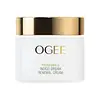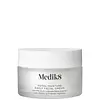What's inside
What's inside
 Key Ingredients
Key Ingredients

 Benefits
Benefits

 Concerns
Concerns

 Ingredients Side-by-side
Ingredients Side-by-side

Aloe Barbadensis Leaf Juice
Skin ConditioningSimmondsia Chinensis Seed Oil
EmollientCetearyl Alcohol
EmollientGlycerin
HumectantLauryl Laurate
Skin ConditioningWater
Skin ConditioningRicinus Communis Seed Oil
MaskingPolyglyceryl-3 Stearate
EmulsifyingAlcohol
AntimicrobialCocos Nucifera Oil
MaskingInulin
Skin ConditioningSclerotium Gum
Emulsion StabilisingVitis Vinifera Seed Oil
EmollientPhenethyl Alcohol
MaskingCopernicia Cerifera Wax
Raspberry Ketone
MaskingCeramide NP
Skin ConditioningSodium Levulinate
Skin ConditioningCitric Acid
BufferingAcmella Oleracea Extract
Skin ProtectingSodium Anisate
AntimicrobialSodium Phytate
Glyceryl Caprylate
EmollientGlyceryl Laurate
EmollientLavandula Angustifolia Oil
MaskingGenipa Americana Fruit Extract
Skin ConditioningTanacetum Annuum Flower Oil
MaskingPhytosphingosine
Skin ConditioningSodium Hyaluronate
HumectantLinalool
PerfumingAloe Barbadensis Leaf Juice, Simmondsia Chinensis Seed Oil, Cetearyl Alcohol, Glycerin, Lauryl Laurate, Water, Ricinus Communis Seed Oil, Polyglyceryl-3 Stearate, Alcohol, Cocos Nucifera Oil, Inulin, Sclerotium Gum, Vitis Vinifera Seed Oil, Phenethyl Alcohol, Copernicia Cerifera Wax, Raspberry Ketone, Ceramide NP, Sodium Levulinate, Citric Acid, Acmella Oleracea Extract, Sodium Anisate, Sodium Phytate, Glyceryl Caprylate, Glyceryl Laurate, Lavandula Angustifolia Oil, Genipa Americana Fruit Extract, Tanacetum Annuum Flower Oil, Phytosphingosine, Sodium Hyaluronate, Linalool
Water
Skin ConditioningGlycerin
HumectantDimethicone
EmollientSqualane
EmollientCaprylic/Capric Triglyceride
MaskingBis-PEG-18 Methyl Ether Dimethyl Silane
EmollientPentaerythrityl Tetraethylhexanoate
EmollientPropanediol
SolventArachidyl Alcohol
EmollientCetearyl Alcohol
EmollientInulin
Skin ConditioningBehenyl Alcohol
EmollientPhenoxyethanol
PreservativeArachidyl Glucoside
EmulsifyingTocopheryl Acetate
AntioxidantCaprylyl Glycol
EmollientLinoleic Acid
CleansingSaccharomyces Ferment Filtrate
HumectantGlyceryl Glucoside
HumectantSodium Hyaluronate
HumectantAcetyl Heptapeptide-4
HumectantLinolenic Acid
CleansingCetearyl Glucoside
EmulsifyingSodium Polyacryloyldimethyl Taurate
Emulsion StabilisingDiglycerin
HumectantCeramide NP
Skin ConditioningSodium PCA
HumectantUrea
BufferingCarbomer
Emulsion StabilisingDisodium EDTA
Hydrogenated Polydecene
EmollientEthylhexylglycerin
Skin ConditioningXanthan Gum
EmulsifyingAcrylates/C10-30 Alkyl Acrylate Crosspolymer
Emulsion StabilisingSodium Hydroxide
BufferingLactic Acid
BufferingLysine
Skin ConditioningPCA
HumectantSorbitol
HumectantButylene Glycol
Humectant1,2-Hexanediol
Skin ConditioningTrideceth-10
CleansingTocopherol
AntioxidantHydrolyzed Wheat Protein
Skin ConditioningAllantoin
Skin ConditioningOryza Sativa Lees Extract
Skin ConditioningWater, Glycerin, Dimethicone, Squalane, Caprylic/Capric Triglyceride, Bis-PEG-18 Methyl Ether Dimethyl Silane, Pentaerythrityl Tetraethylhexanoate, Propanediol, Arachidyl Alcohol, Cetearyl Alcohol, Inulin, Behenyl Alcohol, Phenoxyethanol, Arachidyl Glucoside, Tocopheryl Acetate, Caprylyl Glycol, Linoleic Acid, Saccharomyces Ferment Filtrate, Glyceryl Glucoside, Sodium Hyaluronate, Acetyl Heptapeptide-4, Linolenic Acid, Cetearyl Glucoside, Sodium Polyacryloyldimethyl Taurate, Diglycerin, Ceramide NP, Sodium PCA, Urea, Carbomer, Disodium EDTA, Hydrogenated Polydecene, Ethylhexylglycerin, Xanthan Gum, Acrylates/C10-30 Alkyl Acrylate Crosspolymer, Sodium Hydroxide, Lactic Acid, Lysine, PCA, Sorbitol, Butylene Glycol, 1,2-Hexanediol, Trideceth-10, Tocopherol, Hydrolyzed Wheat Protein, Allantoin, Oryza Sativa Lees Extract
 Reviews
Reviews

Ingredients Explained
These ingredients are found in both products.
Ingredients higher up in an ingredient list are typically present in a larger amount.
Ceramide NP is a type of ceramide and formally known as ceramide 3.
Ceramides are intercellular lipids naturally found in our skin that bonds dead skin cells together to create a barrier. They are known for their ability to hold water and thus are a great ingredient for dry skin.
Ceramides are an important building block for our skin barrier. A stronger barrier helps the skin look more firm and hydrated. By bolstering the skin ceramides act as a barrier against irritating ingredients. This can help with inflammation as well.
If you would like to eat ceramides, sweet potatoes contain a small amount.
Read more about other common types of ceramides here:
Ceramide AP
Ceramide EOP
Cetearyl alcohol is a mixture of two fatty alcohols: cetyl alcohol and stearyl alcohol. It is mainly used as an emulsifier. Emulsifiers help prevent the separation of oils and products. Due to its composition, it can also be used to thicken a product or help create foam.
Cetearyl alcohol is an emollient. Emollients help soothe and hydrate the skin by trapping moisture.
Studies show Cetearyl alcohol is non-toxic and non-irritating. The FDA allows products labeled "alcohol-free" to have fatty alcohols.
This ingredient is usually derived from plant oils such as palm, vegetable, or coconut oils. There is debate on whether this ingredient will cause acne.
Due to the fatty acid base, this ingredient may not be Malassezia folliculitis safe.
Learn more about Cetearyl AlcoholGlycerin is already naturally found in your skin. It helps moisturize and protect your skin.
A study from 2016 found glycerin to be more effective as a humectant than AHAs and hyaluronic acid.
As a humectant, it helps the skin stay hydrated by pulling moisture to your skin. The low molecular weight of glycerin allows it to pull moisture into the deeper layers of your skin.
Hydrated skin improves your skin barrier; Your skin barrier helps protect against irritants and bacteria.
Glycerin has also been found to have antimicrobial and antiviral properties. Due to these properties, glycerin is often used in wound and burn treatments.
In cosmetics, glycerin is usually derived from plants such as soybean or palm. However, it can also be sourced from animals, such as tallow or animal fat.
This ingredient is organic, colorless, odorless, and non-toxic.
Glycerin is the name for this ingredient in American English. British English uses Glycerol/Glycerine.
Learn more about GlycerinInulin is a polysaccharide (carbohydrate) with prebiotic and antioxidant properties.
The majority of inulin is extracted from chicory, but can also be obtained from other plants such as garlic, onion, asparagus, and sugarcane.
Studies show inulin may help with controlling your skin's natural microbiota when applied topically.
The antioxidant potential of inulin varies depending on the source.
Learn more about InulinSodium Hyaluronate is hyaluronic acid's salt form. It is commonly derived from the sodium salt of hyaluronic acid.
Like hyaluronic acid, it is great at holding water and acts as a humectant. This makes it a great skin hydrating ingredient.
Sodium Hyaluronate is naturally occurring in our bodies and is mostly found in eye fluid and joints.
These are some other common types of Hyaluronic Acid:
Learn more about Sodium HyaluronateWater. It's the most common cosmetic ingredient of all. You'll usually see it at the top of ingredient lists, meaning that it makes up the largest part of the product.
So why is it so popular? Water most often acts as a solvent - this means that it helps dissolve other ingredients into the formulation.
You'll also recognize water as that liquid we all need to stay alive. If you see this, drink a glass of water. Stay hydrated!
Learn more about Water